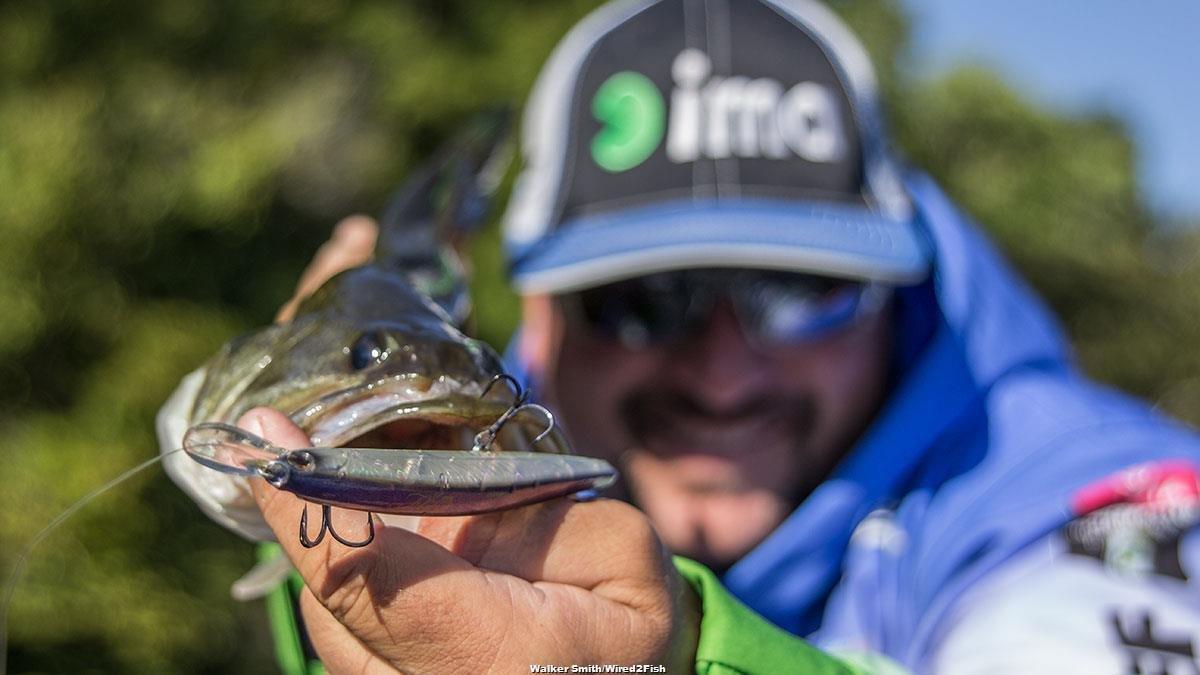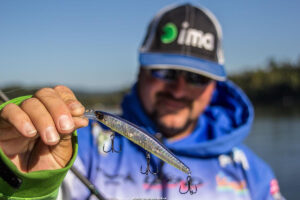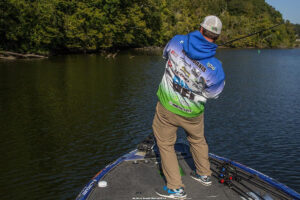Another wintertime jerkbait fishing article”” let’s all go ahead and get our collective groans and eye rolls out of the way. It seems like everywhere you look this time of year, photos of jerkbaits and success stories flood your eyeballs and overload your mind with the latest tips and techniques. Does it get a bit monotonous at times? You bet it does.
That’s precisely the reason we tapped the brain of Elite Series pro Fred Roumbanis for this piece. His vast experience on clearwater Ozark fisheries has developed him into quite the jerkbait aficionado. Combine this knowledge with an unyielding drive to challenge conventional bass fishing knowledge and you’ll quickly realize that this won’t be the typical “jerk, jerk, pause” article you’re accustomed to reading.
He has spent countless hours this winter tinkering and perfecting his jerkbait game and has discovered some factors and variables that just might change the way you fish these age-old lures.
- The method to the madness
- Color changes amplify size
- Bronze hooks are lighter
- Braided line serves as a strike indicator
- Twitch before you jerk
- Drop ’em tail-down before making a cast
Why so much jerkbait talk during the winter?
Before we delve into Roumbanis’ more intricate findings, it’s important to quickly outline the most pertinent reasons for utilizing a jerkbait in cold water. Yes, it’s cold and these long, skinny lures have long been synonymous with harsh, winter fishing conditions. But why is that the case?
- Slow-motion behavior“” “A suspending jerkbait can stay in a very small, specific strike zone for an incredibly long time,” Roumbanis said. “When the water temperatures are in the 40 to 50-degree range, these bass don’t want to chase and become suspended. I’ve seen hundreds of them chase and follow a jerkbait and have been blown away by their slow-motion behavior. No other lure can target suspended, incredibly lethargic bass at such a painstakingly slow pace.”
- Congregations of bass“” Although most wintertime jerkbait fishing is conducted at a snail’s pace, you’d be surprised by how much water you’re able to cover in a day’s time. This is important, according to Roumbanis, because coldwater bass are notorious for assembling in key areas such as channel swings and bluff walls. You’ll need to eliminate large expanses of “dead” water, but a jerkbait allows you to do so both efficiently and effectively.
- Shad kill“” “Don’t get so caught up in the bass behavior that you forget about the shad kill,” Roumbanis said. “When the water temperatures reach the 36-degree range for a prolonged period, lots of shad are going to die. When this kill initially occurs, bass are dumb and easy to catch. But once it’s a full-blown deal, it’s incredibly difficult to get bit. Why would they want to eat a lure when hundreds of dead shad are available?”
Slight color changes can amplify profile
Many of us put a lot of time and effort into finding the “perfect” jerkbait size. We’ll search high and low for something””anything””that will clue us into a fishery’s primary forage size. After all, it’s all about matching the hatch, right?
“Forage size is certainly a very big factor,” Roumbanis said. “But you don’t necessarily need to have a hundred different-sized jerkbaits crammed into your boat or tackle box. You can actually take your favorite jerkbait, such as an Ima Flit 120, and change the color to make it appear larger or smaller to the bass.”
It sounds crazy, but it makes a lot of sense. His thought process and reasoning is quite simple and easy to follow.
- Opaque colors“” “When you take a bone white jerkbait and compare it to a translucent-colored jerkbait in the water, it will look considerably larger,” Roumbanis said. “So when I’m seeing large concentrations of big gizzard shad in an area, I’ll often use an opaque color to boost my lure’s profile. It’s often thought that such colors are only productive under cloudy skies or stained water, but I’ve won a fair amount of money utilizing this technique in clear water.”
- Translucent colors“” On the contrary, Roumbanis believes translucent colors can make a rather large, three-hook jerkbait look much smaller to nearby bass. While he will use a smaller Ima Foxy Fry in very specific situations, he’ll often change to a translucent color such as ghost minnow first in hopes of maintaing the hooking power of a three-hook jerkbait.
Bronze hooks can be a better option
The importance of proper treble hooks on a jerkbait should never be overlooked. Sure””you can have the sexiest jerkbait on Planet Earth, but it won’t do you much good if they’re unable to effectively penetrate the bass’ mouth and pin them throughout a long fight.
While every angler has a different opinion on this issue, Roumbanis has noticed something very specific in regards to his hook selection.
“Typically, I like to leave the original hooks on my Ima Flit 120 for the first half of the day,” Roumbanis said. “They’re usually pretty dialed-in. But if I’m having issues with my hookup ratio, I’ll use a bronze No. 4 Gamakatsu EWG treble hook. Those bronze hooks have lighter wire and aren’t as heavy as nickel-plated hooks, which allows the jerkbait to suspend properly on an extended pause. The EWG style is important as well because when you hook a bass””especially a smallmouth””and it’s hot, that aggressive bend helps pin the bass a little better.”
Braided line for jerkbait fishing?
Perhaps Roumbanis’ most exciting find this winter has been the effectiveness of braided main line on his jerkbait reel. Although many of us are “trained” to use 8-pound fluorocarbon in every situation, braided line offers several distinct advantages.
- Bite indicator“” “When you’re fishing a jerkbait this time of year, very rarely will you experience bone-jarring strikes,” Roumbanis said. “So it’s crucial to use equipment that will make it easier to indicate soft, subtle bites. I’ve been using bright-colored 30-pound braid on my 6.5:1 Ardent Apex Elite Casting Reel with a 5 to 6-foot 10-pound P-Line Ultimate Fluorocarbon leader. The braid floats on the water’s surface, so I’m able to see the line jump with even the smallest bite. It often looks like the ‘tick, tick’ of a shaky head bite. I’ve honestly noticed a tremendous increase in my success since experimenting with this combination.”
- Easier hooksets“” Due to the low-stretch properties of braided line, big, sweeping hooksets aren’t often necessary. Instead, Roumbanis waits for his line to jump and simply lowers his rod tip while reeling quickly. More times than not, he’ll swing a bass with a face full of treble hooks into his boat.
Less jerking and more twitching
Cold water. Jerkbait. Jerk, jerk, pause. We hear it until we’re blue in the face. According to Roumbanis, however, you might get more bites by kicking it down a few notches and going against the traditional cadence.
- A winding jerk“” Before beginning your cadence, it’s important to ensure that your jerkbait has reached its optimum operating depth. If you simply cast the lure and immediately begin your retrieve, there’s a good chance you’re fishing above the bass. To achieve maximum depth, Roumbanis executes a few “winding jerks” after his jerkbait hits the water. This allows the jerkbait to reach its horizontal plane quickly, thus spending more time in the most productive strike zone.
- Small twitches“” “When you’re using braided line for jerkbaits, you have to understand that emphatic jerks are going to move the bait much more than with a fluorocarbon setup,” Roumbanis said. “I’ll actually go with a ‘twitch, twitch, pause’ cadence in which I only move the tip of my rod 8 to 10 inches. These smaller rod movements also help me avoid ripping the hooks away from the fish. Sometimes you can’t detect the bite regardless of your setup, so when you twitch and feel pressure, smaller rod movements are less likely to take the jerkbait away from the bass.”
- A soft rod is imperative“” Roumbanis prefers using a rod with a very soft tip so his twitches have a less drastic effect on his jerkbait””remember, it’s all about keeping the jerkbait in the same area for as long as possible. He’s been experimenting a lot this offseason and has found the 3-power, 6-foot, 9-inch medium-action iROD Genesis II Series to be an excellent choice.
Drop ’em tail-down
With time, you’ll find that not all jerkbaits are created equal””some dart while others slide and some suspend differently than others. So how do you know what constitutes a “good” jerkbait? Above all else, there’s one test Roumbanis performs with each and every jerkbait before making a single cast.
“If you drop a jerkbait tail-down into the water, it should slowly level itself out,” Roumbanis said. “I want that jerkbait to stay as level as possible, so I look for the tail to effectively bottom out while the head slowly rises to create a very horizontal profile. This ensures that, when you pause that jerkbait and there’s a big bass staring at it, it’s going to look natural and stay completely still the entire time.”
Yes, it’s true. Jerkbaits and cold water are a phenomenal combination that can load your boat in a hurry. If you’re having trouble getting bites with more commonplace tactics, however, don’t be afraid to go against the grain. Sometimes all it takes is some simple experimentation to turn a tough day into an unforgettable one.
















